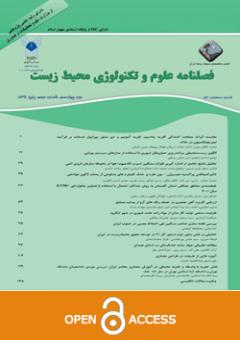Explanation of renewable energy development strategy based on forestry biomass in order to reduce energy consumption in buildings (Case study: Lahijan city)
Subject Areas : Renewable EnergyShahaboddin Ziaolhagh 1 , Neda Ziabakhshnes 2 * , Mehrdad Javidinejad 3
1 - P.h.D. Student Department of Architecture, Islamic Azad University, Professor Hesabi, Tafresh, Iran.
2 - Assistant Professor, Department of Architecture, North Tehran Branch. Islamic Azad University, Tehran, Iran. *(Corresponding Author)
3 - Assistant Professor, Department of Architecture and Urban Planning, Central Tehran Branch, Islamic Azad University Tehran, Iran.
Keywords: Biomass, Renewable energy, Building, Optimization, Lahijan city. ,
Abstract :
Background and Objective: Today, due to insufficient attention to non-renewable energy resources, a significant portion of these resources is wasted in buildings, which not only leads to their depletion but also contributes to air pollution in urban and rural areas. The main objective of this research is "to develop strategies for utilizing renewable energy based on forestry biomass to reduce energy consumption in buildings in the city of Lahijan."
Material and Methodology: This research is descriptive-analytical in nature and follows a qualitative-quantitative approach, conducted in the city of Lahijan. For data analysis, SWOT and ANP techniques were used.
Findings: The findings showed that the lack of efficient policies for optimal use of forestry and agricultural waste has led to a reduced willingness of the community to adopt accessible renewable energy in the temperate and humid regions of Iran, especially in the city of Lahijan. However, with a change in government approaches, exponential growth in the use of this type of energy can be expected in the long run.
Discussion and Conclusion: due to the low cost of using biomass, the speed of using this energy can be exponentially increased in a short time among the general population of the Caspian regions, which will reduce the use of fossil fuels and it is general household expenses. This will be an incentive for more people in the target community to use renewable energy in order to preserve natural resources.
1. Rahimian, R., 2003. Characteristics of energy consumption in heating and air conditioning systems, Tehran: Publications of Organization of Fuel Consumption Optimization. (In Persian)
2. Sattari, M. 2004. Residential Sector Demand Model, Fuel Consumption Optimization Organization Publications, Tehran. (In Persian)
3. Bahadrinejad, M. 1995. Ventilation and natural cooling in traditional buildings of Iran, Tehran: University Press. (In Persian)
4. Razjovian, M. 2007. Comfort in the shelter of climate compatible architecture, Tehran: Beheshti University Press. (In Persian)
5. Naser M, Mostahfezian M, Karimian J, Zahedi H. 2021. Green Resource Management and Its Impact on the Organizational Sustainability Considering the Mediating Role of Environmental Performance and Empowerment. healthMan&InfoSci.8(3):185-190. https://doi.org/10.30476/JHMI.2022.91533.1086.
6. Iran National Oil Company, 2021, what the energy manager should know about energy-related figures and statistics, Tehran. [In Persian].
7. Sheikhi As, Mahmoudi, A, Ranchbar A, Farahbakhsh S. 2017. Designing renewable energy systems: adapted from the book Renewable Energy Resources, Tehran: Science Publishing Center. (In Persian)
8. Ranesi, A.; Faria, P.; Correia, R.; Freire, M.T.; Veiga, R.; Gonçalves, M. 2022, Gypsum Mortars with Acacia dealbata BiomassWaste Additions: Effect of Different Fractions and Contents. Buildings, 12, 339. https://doi.org/10.3390/buildings12030339.
9. Sertolli, A.; Gabnai, Z.; Lengyel, P.; Bai, A. 2022, Biomass Potential and Utilization inWorldwide Research Trends-A Bibliometric Analysis. Sustainability, 14, 5515. https://doi.org/10.3390/su14095515.
10. Srithar, K.; Rajaseenivasan, T.; Arulmani, M.; Gnanavel, R.; Vivar, M.; Fuentes, M. 2018. Energy recovery from a vapour compression refrigeration system using humidification dehumidification desalination. Desalination, 439(3), 155-161. https://doi.org/10.1016/j.desal.2018.04.008.
11. Paul B, (2015), Worldforest and agricultural crop residue resources for cofiring Worldforest and agricultural crop residue resources for cofiring, 1-66. http://dx.doi.org/10.13140/RG.2.2.36612.78724.
12. Srivastava. A & Arunabh M, 2023, On trending technologies of aluminium dross recycling, Process Safety and Environmental Protection, 171(2), 38-54, https://doi.org/10.1016/j.psep.2023.01.010.
13. Clark, L. V.; Dwiyanti, M.S.; Anzoua, K.G.; Brummer, J. E.; Ghimire, B.k; Głowacka, K; Hall, M; Heo, K; Jin, X; Lipka, A. E.; Peng, J; Yamada, T; Yoo, J; Yu, C. Y; Zhao, H; Long, S. P.; Sacks, E. J. 2019. Biomass yield in a genetically diverse Miscanthus sinensis germplasm panel evaluated at five locations revealed individuals with exceptional potential. GCB Bioenergy, 11(10), 38-56. https://doi.org/10.1111/gcbb.12606.
14. Carpita, N. C & McCann, M. C, 2020. Redesigning plant cell walls for the biomass-based bioeconomy. Journal of Biological Chemistry, 295(1), 15144-15157. https://doi.org/10.1074/jbc.REV120.014561.
15. Gital Durmaz, Y & Bilgen, B, 2020. Multi-objective optimization of sustainable biomass supply chain network design. Applied Energy, 272(153), 115259. https://doi.org/10.1016/j.apenergy.2020.115259.
16. Jouhara H, Khordehgah, N, Almahmoud, S, Delpech. B, Chauhan, A, Savvas A. T, 2018, Waste heat recovery technologies and applications, Thermal Science and Engineering Progress, 6, 268-289. https://doi.org/10.1016/j.tsep.2018.04.017.
17. Clauser, N.M.; González, G.; Mendieta, C.M.; Kruyeniski, J.; Area, M.C.; Vallejos, M.E. 2021, Biomass Waste as Sustainable Raw Material for Energy and Fuels. Sustainability, 13, 794. https://doi.org/10.3390/su13020794.
18. Pishvaee, M.S.; Mohseni, S.; Bairamzadeh, S. 2021, An overview of biomass feedstocks for biofuel production. In Biomass to Biofuel Supply Chain Design and Planning under Uncertainty; In book: Biomass to Biofuel Supply Chain Design and Planning Under Uncertainty, Elsevier: Amsterdam, The Netherlands. 1-20. http://dx.doi.org/10.1016/B978-0-12-820640-9.00001-5.
19. Sharma, G; Kaur, M; Punj, S; Singh, K, 2020. Biomass as a sustainable resource for value‐added modern materials: a review. Biofuels, Bioproducts and Biorefining, 14(3). 673-695. https://doi.org/10.1002/bbb.2079.
20. Siadtan, A., Karimi, H. 2018. Renewable energy sources and standardization of photovoltaic systems connected to the grid, Tehran: Aftab Giti Publications. (In Persian)
21. Khan, Sharukh, Vivek Paliwal, Vikrant Vikram Pandey, Vijay Kumar, 2015, International Advanced Research Journal in Science, Engineering and Technology (IARJSET) National Conference on Renewable Energy and Environment (NCREE-2015) IMS Engineering College, Ghaziabad. 2(1), 301-304. https://doi.org/10.17148/IARJSET.
22. Houghton, R. A. 2008, Biomass, in Jørgensen, Sven Erik; Fath, Brian D. (eds.), Encyclopedia of Ecology, Oxford: Academic Press, ISBN 978-0-08-045405-4, retrieved 2023-01-13.
23. Pormayeh, R., Ramzanpour, M., Bozormehr, K., Haqzad, A.M. 2020. Factors affecting tourism development in Lahijan city, Tourism Space, 9(34), 27-47. (In Persian)

